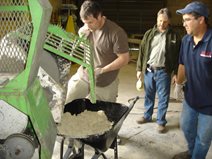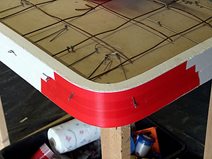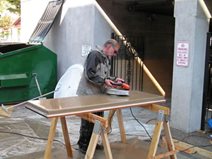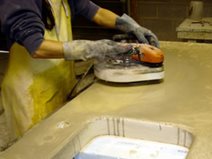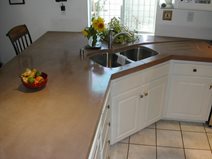- Concrete Tools Home
- Screeds
- Tampers
- Concrete Floats
- Concrete Edgers
- Groovers
- Trowels
- Fresnos
- Power Tools for Concrete
- Choosing the Best Tool for the Job
- Must-Have Tools for Exterior Concrete: The five tools outdoor concrete contractors can’t live without
- Five Must-Have Tools for Decorative Flooring Contractors Create eautiful decorative concrete floors with these five tools
- Five Must-Have Tools for Concrete Countertop Contractors
- Related Information:
- Pouring and Finishing Tool Videos: See demonstrations of floating, troweling, edging, and more
- Concrete Finishing Tips: Creating a high-quality slab
- Product Newsletter: Sign up today to receive monthly updates
Five Must-Have Tools for Concrete Countertop Contractors
The tools concrete countertop fabricators can’t live withoutLike a top chef working without a good set of knifes, a concrete countertop maker lacking the proper tools will not achieve five-star results. The assortment of tools featured here are must-haves for many decorative countertop contractors. Some will help you achieve better mix designs and surface finishes, while others will streamline the forming and casting process. If you want to improve the quality and appearance of your concrete countertops, an investment in any of these tools will be money well spent.
1. Mortar mixer
Although you can mix the small batches of concrete required for countertops in buckets or a wheelbarrow, a portable mortar mixer is more convenient and will blend ingredients more thoroughly. View a video about concrete mixers for countertops.
2. Countertop molds
The final appearance of a countertop will largely depend on the quality and precision of the mold its cast in. You can use a variety of materials to make your mold, as long as they are waterproof or sealed against moisture. Mold-making materials recommended by experienced countertop fabricators include wood, polyurethane foam, metal, melamine and rubber. Learn more.
3. Casting table
A strong, level casting table is essential to properly support the countertop mold and the heavy, wet concrete until it cures. Some fabricators save money by building their own casting tables. But if you plan to buy a table, make sure it’s rigid enough not to sag under the weight of the concrete and large enough to accommodate the average countertop slab. Watch this video to get tips on buying or building a casting table.
4. Handheld grinder and polisher
Using an electric grinder along with a set of diamond pads to grind and polish the countertop surface wilI greatly enhance the appearance by smoothing away minor blemishes, burrs, and rough spots and by exposing some of the decorative aggregate and embedded elements (if used). Learn more about polishing countertops.
5. Concrete vibrator
An electric vibrator is the best way to consolidate and level concrete after it’s placed in the countertop mold. Vibration will greatly improve the appearance of your countertops by removing air pockets in the mix that could leave holes or pits in the surface. Concrete vibration also helps to move the cream layer of the concrete to the bottom of the mold, which will be visible as the top surface of the finished countertop. See a video on how to consolidate concrete countertops.
Related:
Concrete Countertops Buyer’s Guide
Avoiding Concrete Countertop Installation Mistakes
 Encore Finishing Aid
Improve workability and surface quality
Encore Finishing Aid
Improve workability and surface quality
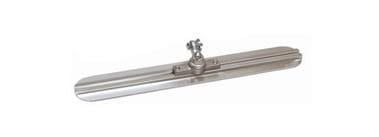 Kraft Concrete Float 24" x 3.25"
Lightweight magnesium float for small areas
Kraft Concrete Float 24" x 3.25"
Lightweight magnesium float for small areas
 DAY1® Finishing Aid
Colloidal silica for easy, fast finishing
DAY1® Finishing Aid
Colloidal silica for easy, fast finishing
